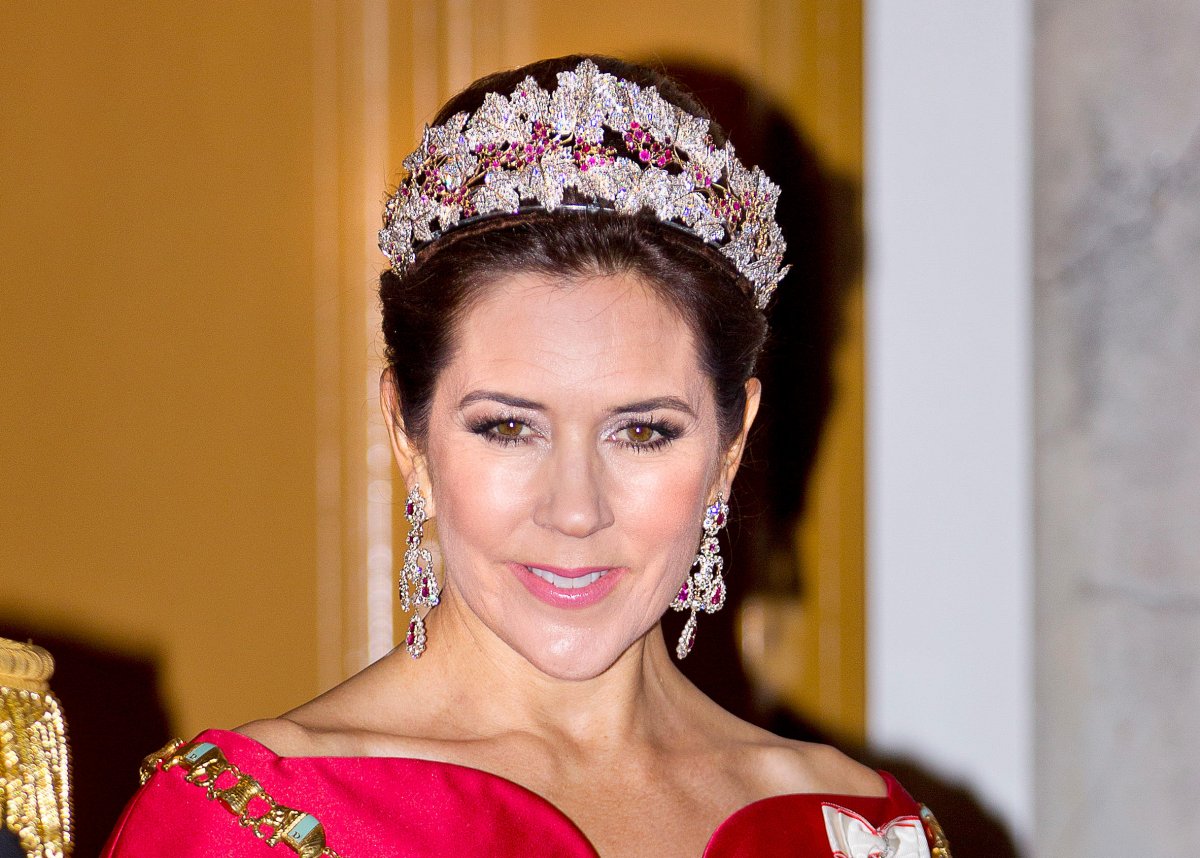
When the Queen of Denmark steps out for gala events, she’s often wearing pieces from a spectacular suite of ruby and diamond jewelry. The remarkable ruby jewels have an impressive history that begins in imperial France and continues today in royal Denmark. Today, we’ve got a look back at the journey of the jewels from Paris to Copenhagen, and an overview of each of the glittering pieces in the evolving parure.
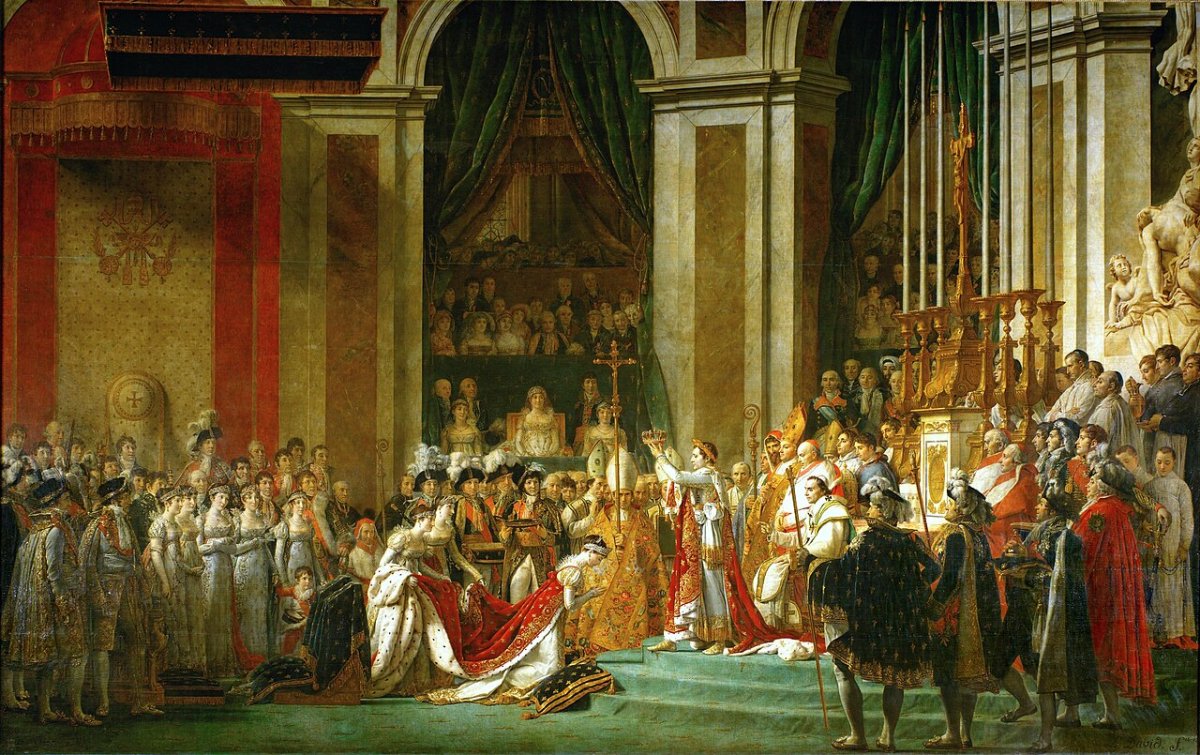
The story of Denmark’s royal rubies begins somewhere else: at the Cathedral of Notre Dame in Paris on December 2, 1804. Napoleon Bonaparte, keen to emphasize his new imperial powers, orchestrated an elaborate coronation ceremony. The entire event was tailored to fit Napoleon’s personal notions of empire. He chose to be crowned in Paris rather than at Reims, as the old French kings had been, and though he convinced Pope Pius VII to come and officiate at the ceremony, Napoleon placed the crown on his head himself.
Part of the image-making exercise of the coronation involved the elaborate clothing and jewels worn by Napoleon, Joséphine, and their courtiers. These included a group of fourteen military leaders whom Napoleon had granted the title of “Marshal of the Empire” earlier in 1804. He wanted each of them, and their wives, to look the part during the coronation ceremony, so he granted them each a substantial sum of money to outfit them for the occasion. Part of the money was earmarked to order new suites of jewelry for their wives.
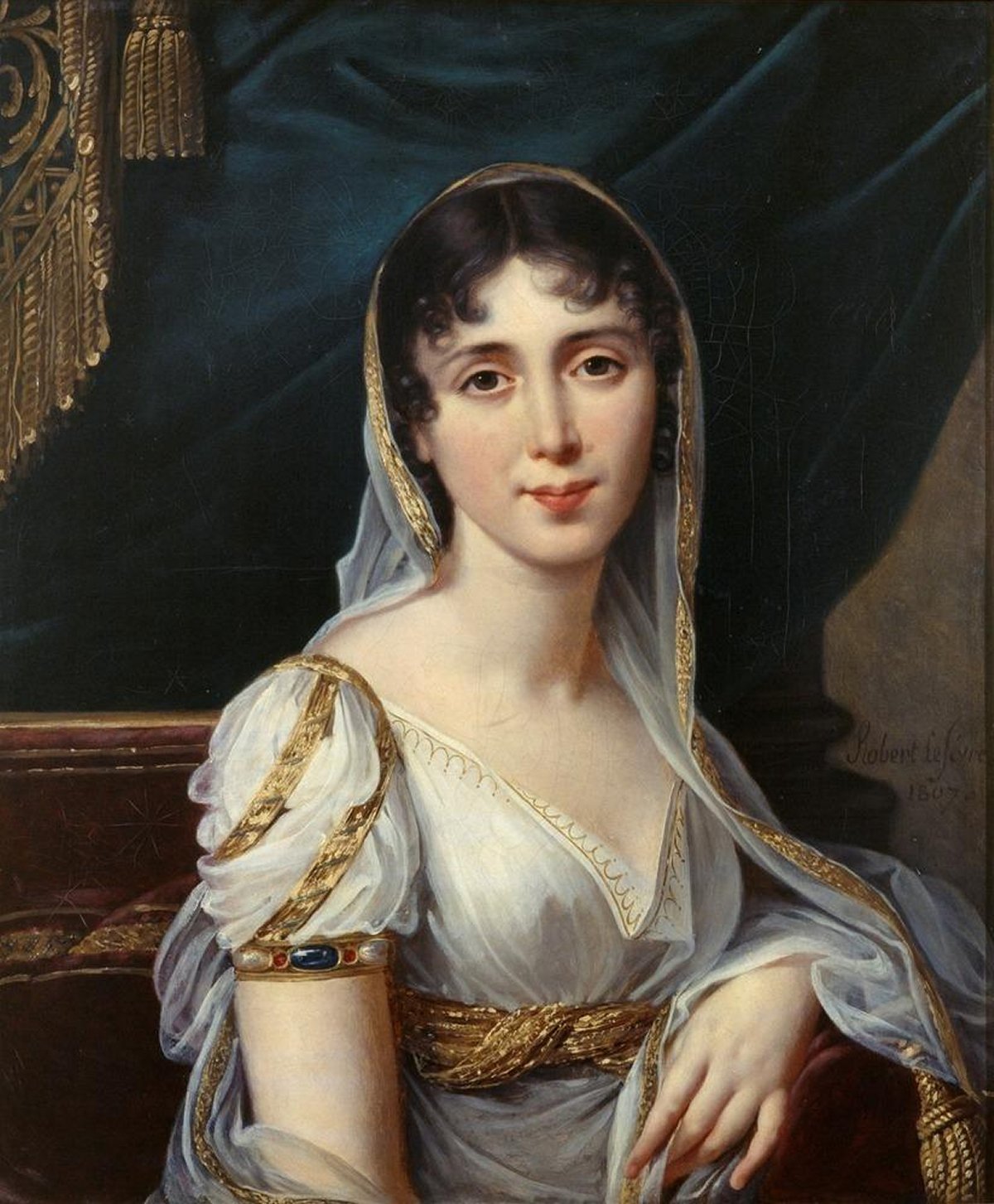
Among the group of marshals was Jean Baptiste Bernadotte, a veteran military officer who had served valiantly in war and later held the posts of Minister of War and Ambassador to Austria. In 1798, Bernadotte had married a woman with extensive Bonaparte connections. Désirée Clary had been briefly engaged to Napoleon in 1795, before his marriage to Joséphine, and her sister was married to Napoleon’s brother, Joseph Bonaparte. Jean Baptiste and Désirée had a son, Oscar, a year after their marriage. While Bernadotte traveled around Europe in both military and diplomatic roles, Désirée remained at home in Paris with their son.
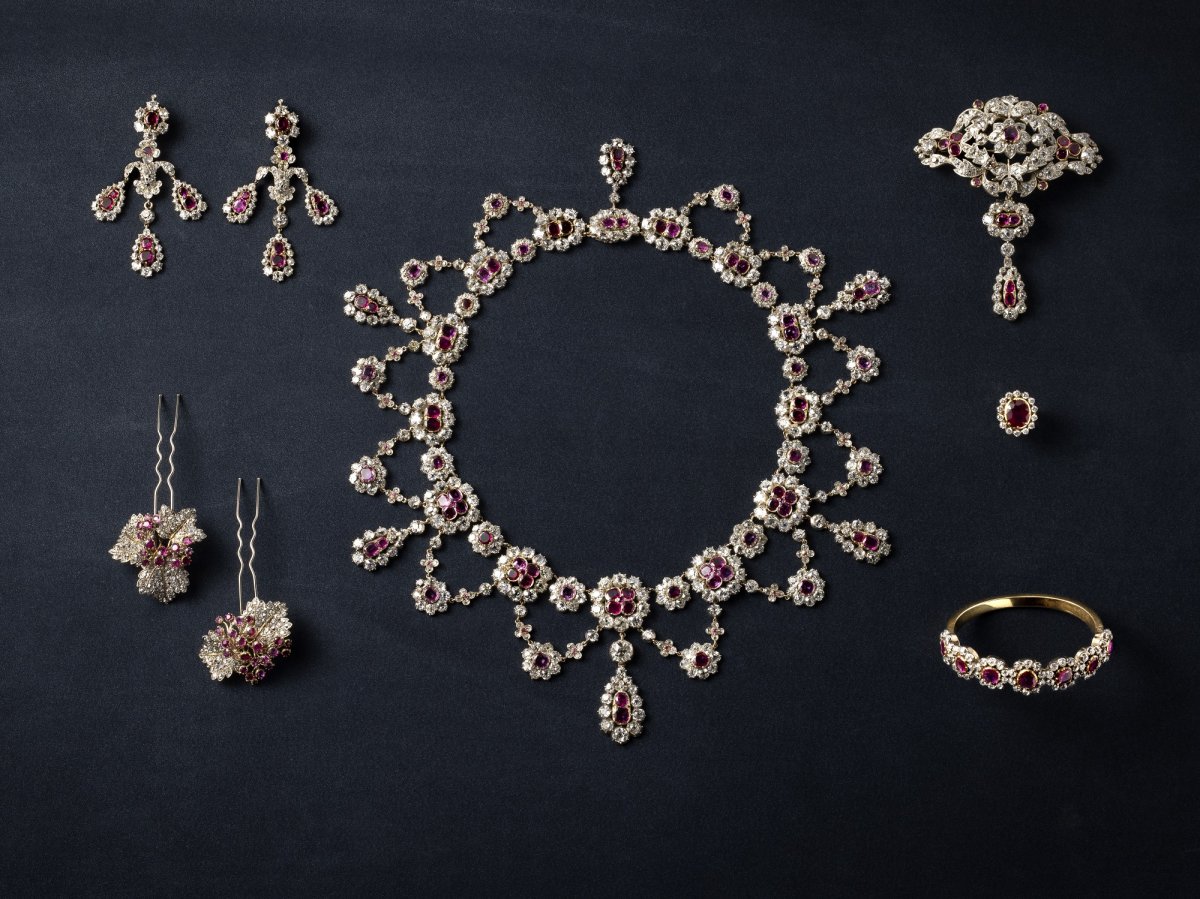
Désirée’s continued closeness with the Bonaparte family, and Bernadotte’s rising through the ranks, meant that they would both play important roles in the imperial coronation of 1804. With the money that Napoleon had given them, the Bernadottes acquired a splendid set of diamond and ruby jewelry for Désirée to wear during the ceremony. The suite, as originally constituted, included a festoon necklace with pendants, a pair of girandole earrings, a large brooch with a pendant, a hair comb, and a set of unique hair ornaments.
Finding large rubies to fit with the jewelry styles that were popular during the first decade of the nineteenth century was difficult—rubies tend to be smaller as a rule, and large ones are exceedingly rare. The jeweler who made the ruby set solved the problem by combining smaller rubies together to mimic the look of larger gemstones.
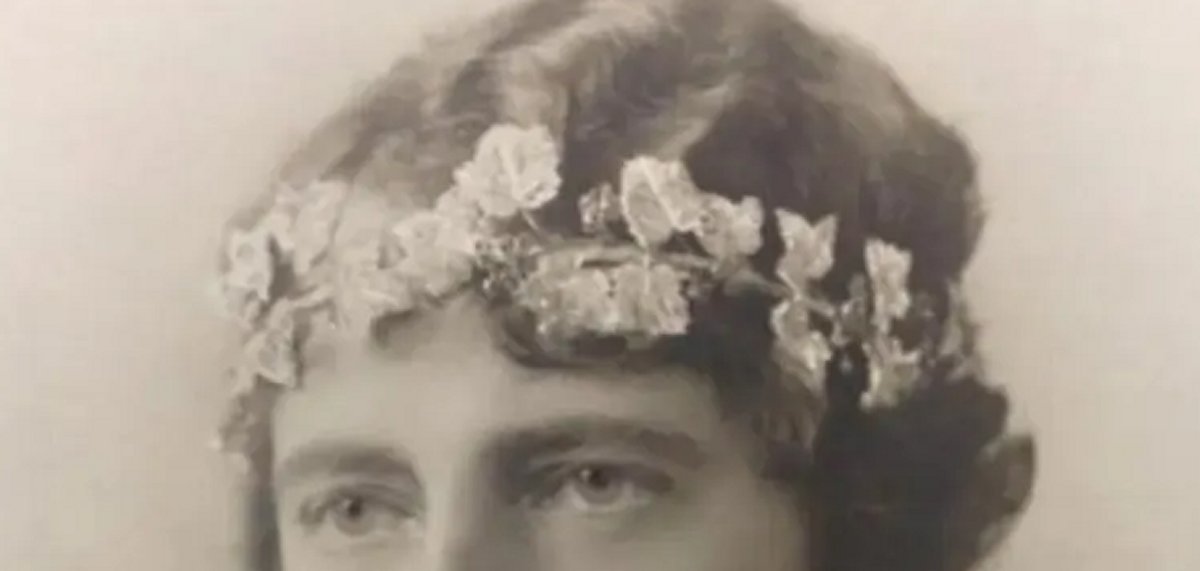
Here’s a look at the hair ornaments, worn together as a bandeau, in a close approximation of their original design. The ornaments were designed as a garland of currant branches with diamond leaves and ruby berries. The branches would have been woven into Désirée’s hair for the coronation. All of the jewelry surely sparkled beautifully as Désirée walked in Joséphine’s imperial procession during the ceremony, carrying the Empress’s veil and handkerchief on a pillow.
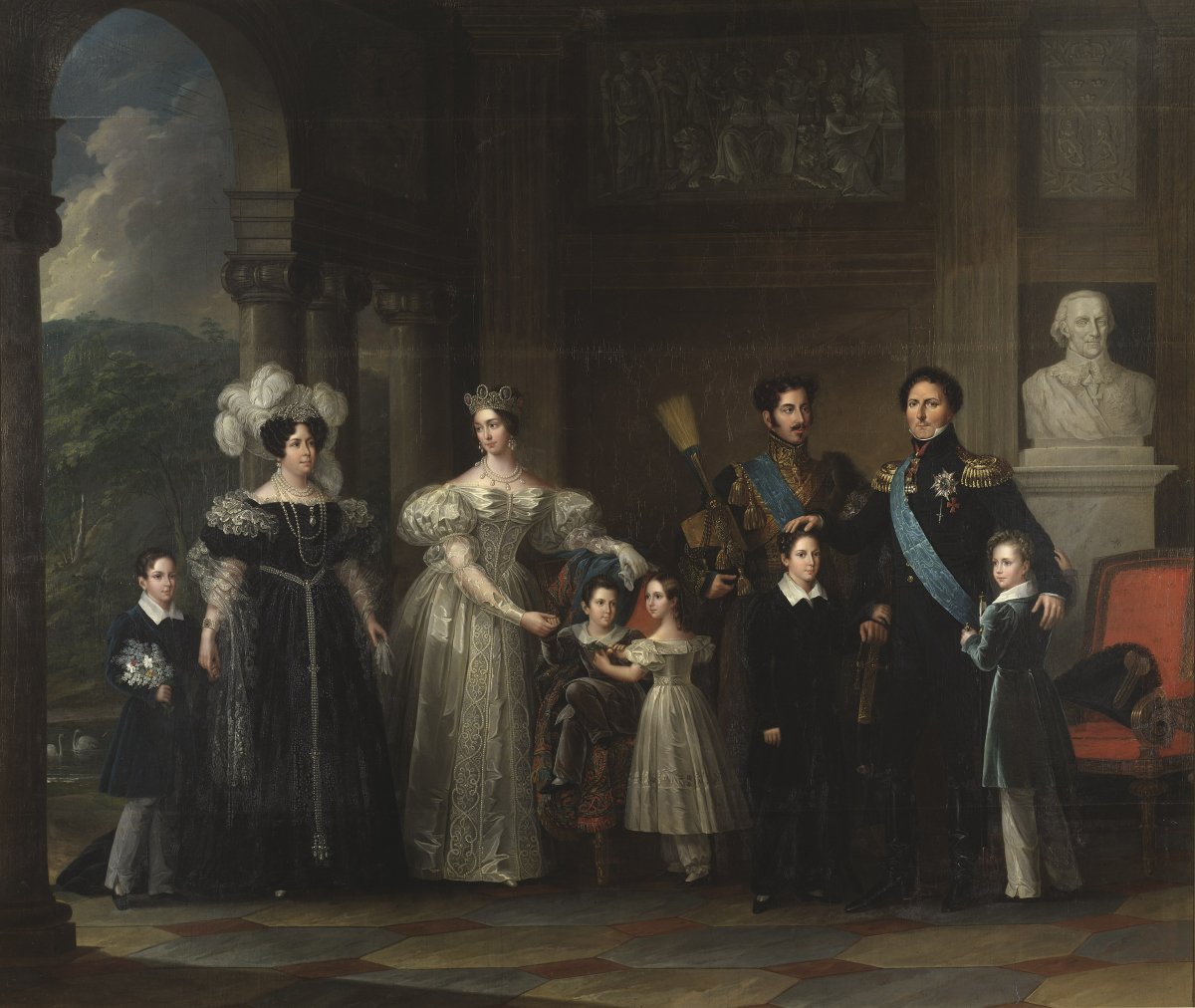
Jean Baptiste Bernadotte’s success in European politics caught the eye of another nation a few years after Napoleon’s coronation ceremony. After serving as a governor in Germany and a prince in Italy, Bernadotte was elected heir to the throne of Sweden in August 1810. Désirée, who loved living in Paris, was pleased with the elevated status that her husband’s new position gave her at court in France, but she did not want to move to Stockholm. She spent little time in Sweden, preferring to continue to reside in Paris even after her husband ascended to the throne as King Carl XIV Johan of Sweden in 1818.
Finally, in 1822, the King discovered a way to lure Désirée to Sweden permanently. Their son, Crown Prince Oscar, fell in love with Princess Joséphine of Leuchtenberg, a granddaughter of both the King of Bavaria and Empress Joséphine of France. The princess’s connections to the Bonaparte family offered a bridge to bring some familiarity to Désirée in Sweden, and she agreed to travel with her new daughter-in-law to Stockholm in 1823. Presumably, Désirée brought her ruby and diamond coronation jewels with her when she arrived in Sweden for the first time in more than a decade. She would end up staying there, with her husband, son, daughter-in-law, and grandchildren, for the rest of her life, until her death in 1860.
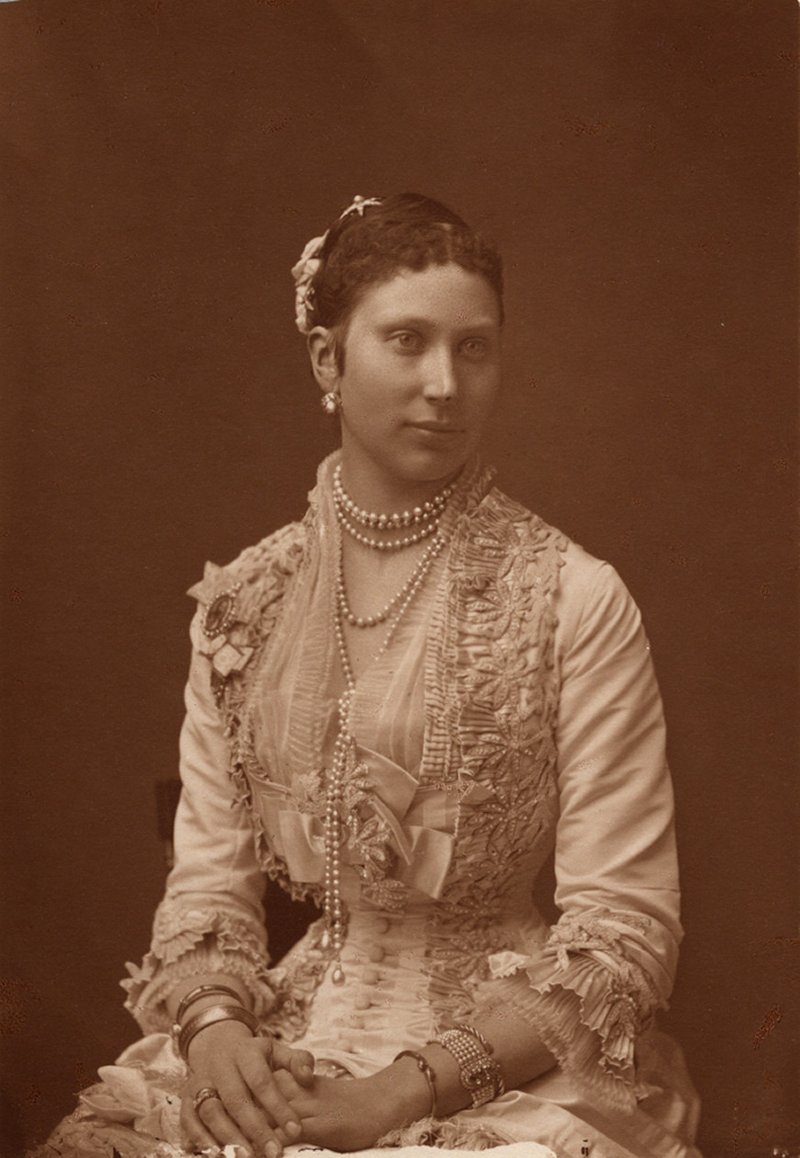
By the time of Désirée’s passing, her husband and her son had both died, and her grandson, King Carl XV, was on the Swedish throne. King Carl’s only surviving child was his daughter, Princess Lovisa, who was barred from inheriting the Swedish crown because she was a woman. Fate would end up sending Lovisa to sit on a different Scandinavian throne. In 1869, nine years after her grandmother’s death, Lovisa married Crown Prince Frederik of Denmark. The alliance was a political one, designed to shore up the relationship between Sweden and Denmark and emphasize Scandinavian unity. Perhaps because Denmark’s national colors are red and white, the ruby and diamond set that originally belonged to Désirée ended up with Lovisa in Copenhagen.
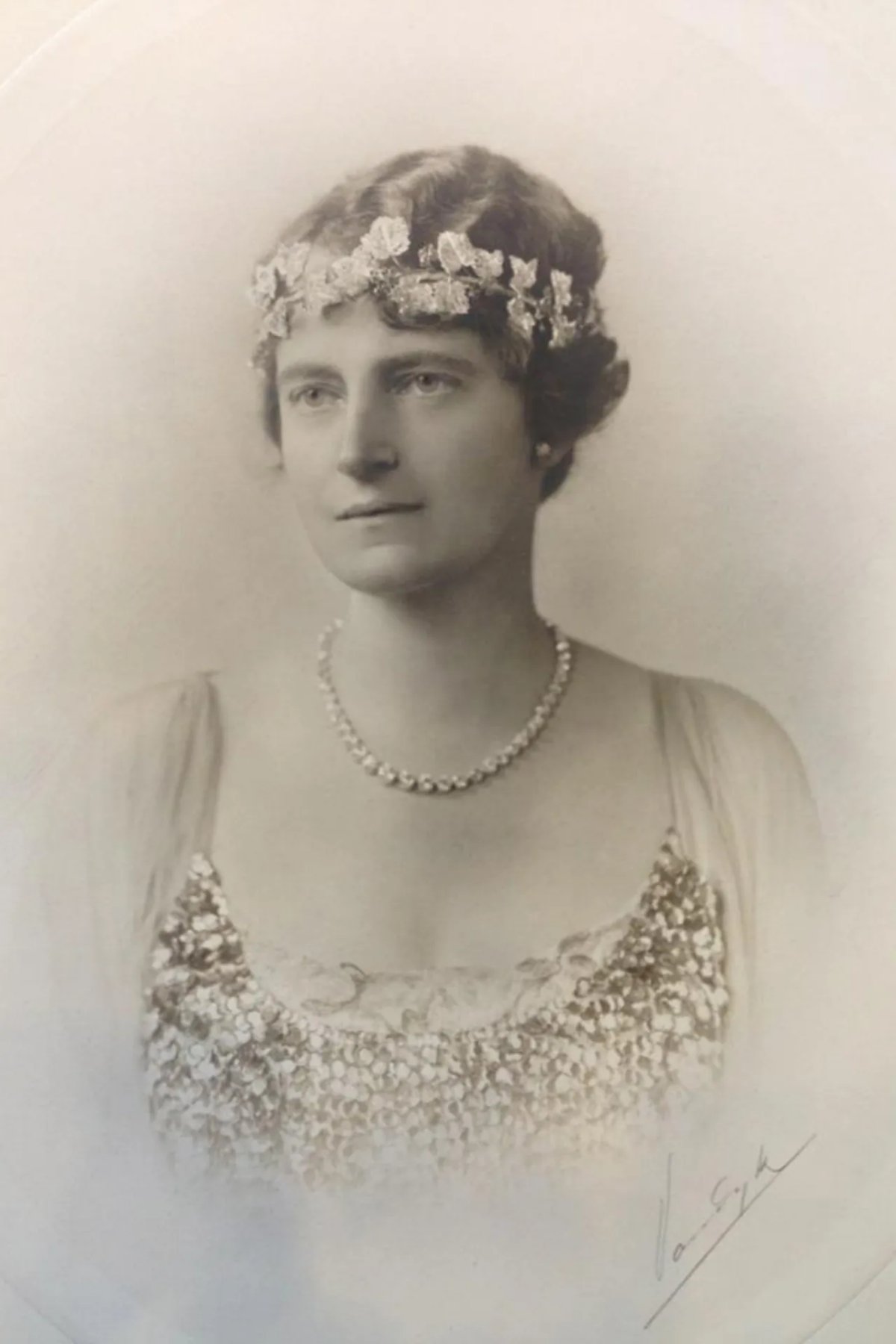
To my knowledge, Lovisa was never pictured wearing her grandmother’s ruby set. In 1898, Lovisa’s elder son, Prince Christian, married Duchess Alexandrine of Mecklenburg-Schwerin, and to mark the occasion, Lovisa offered Alexandrine the currant branch garlands as a wedding present. Alexandrine had the ornaments transformed into a petite bandeau-style wreath tiara, which she wears in the photograph above. When Lovisa passed away in 1926, King Christian and Queen Alexandrine inherited the rest of the set: the festoon necklace, the girandole earrings, the brooch, and a new bracelet that had been made by redesigning the original hair comb from the suite.
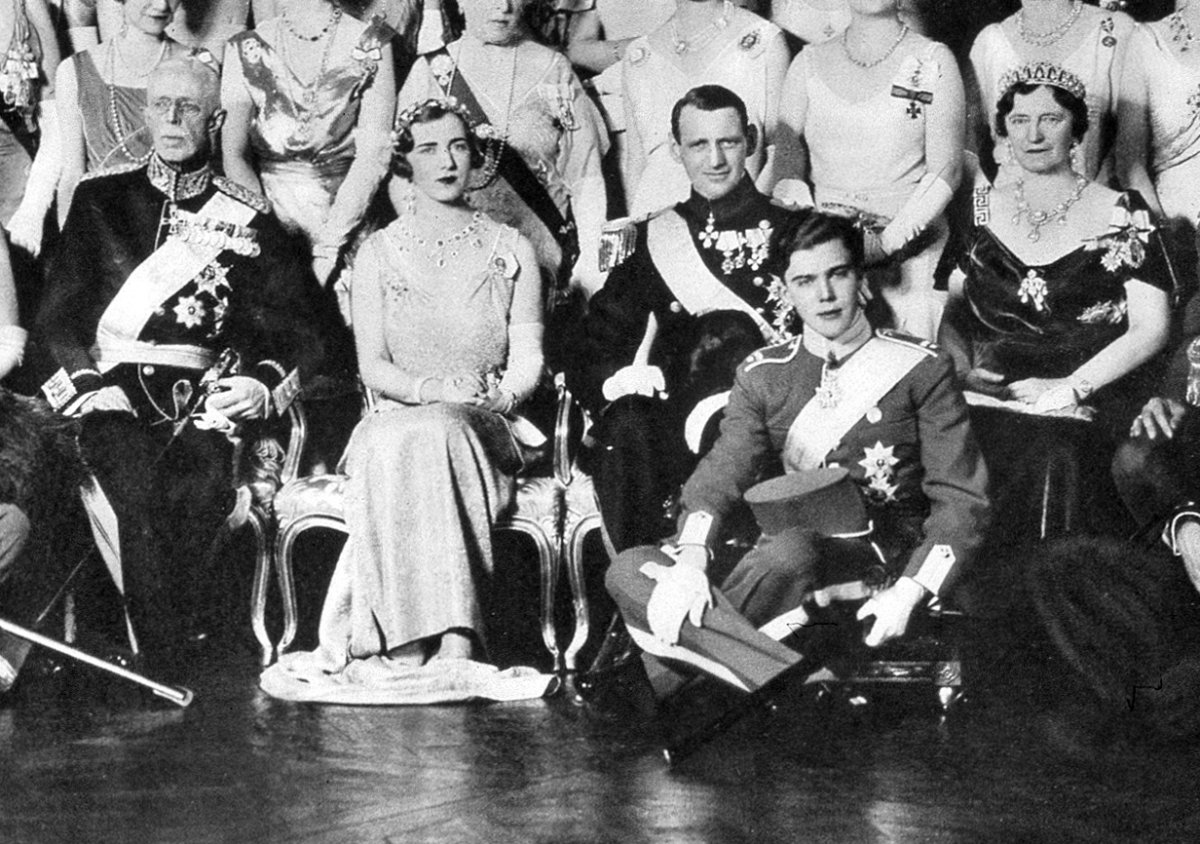
Queen Alexandrine didn’t keep the complete ruby parure in her jewelry box for long. In 1935, her elder son, Crown Prince Frederik, married Princess Ingrid of Sweden in a glittering pair of ceremonies in Stockholm and Copenhagen. Ingrid, a granddaughter of the reigning King of Sweden, was also a great-great-great-granddaughter of Désirée Clary Bernadotte. Alexandrine decided that it would be particularly meaningful to give Désirée’s rubies to Ingrid as a wedding present, reuniting the set with one of her direct descendants. In the photograph above, taken during the wedding celebrations, Ingrid wears the bandeau tiara, the necklace, the earrings, the brooch, and the bracelet from the parure.
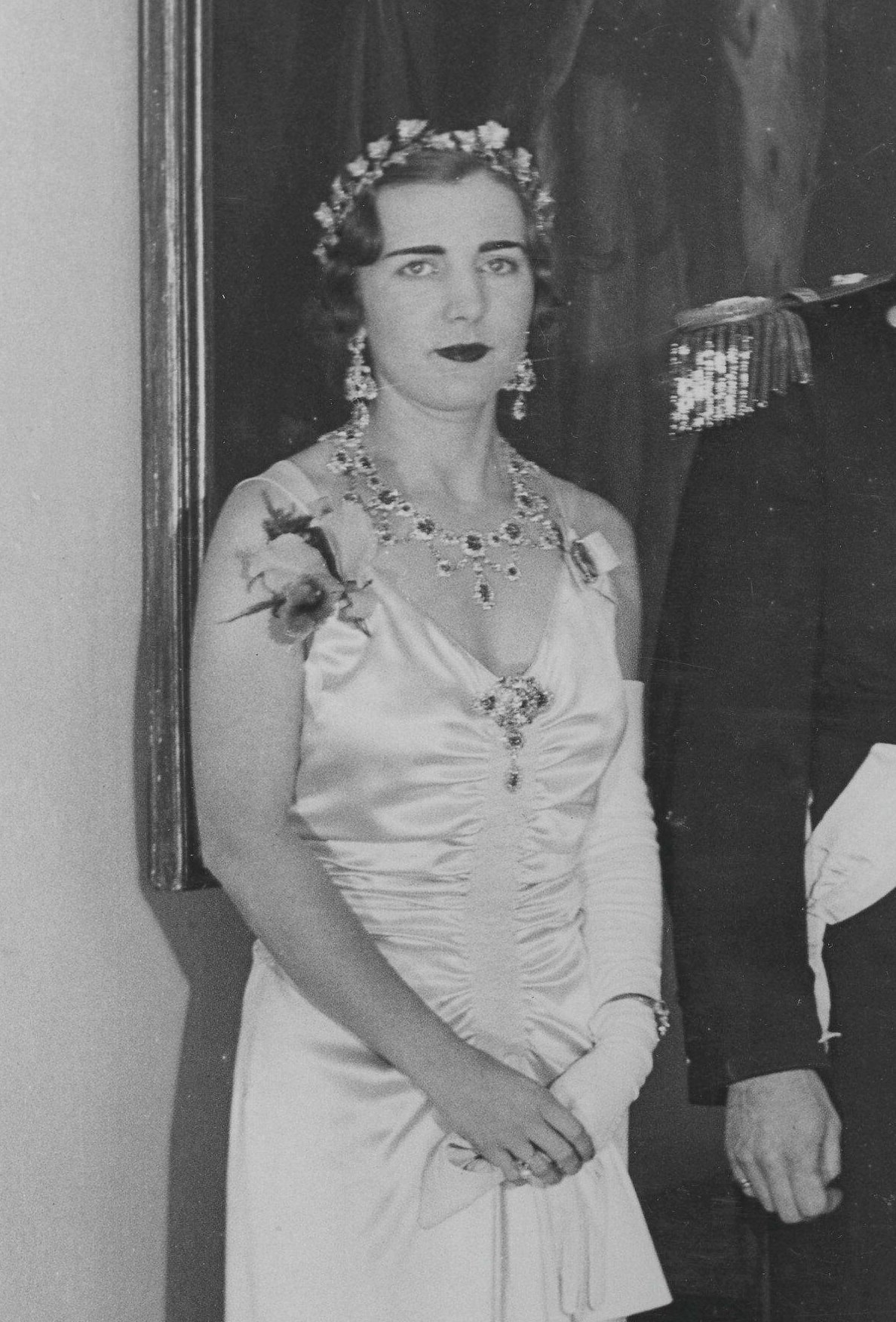
Here’s a better photograph of Ingrid wearing all of the pieces from the ruby set not long after they arrived in her jewelry box. Ingrid was one of the most interesting and successful royal jewelry wearers of her generation, keenly interested in the history of the pieces and dedicated to finding ways to wear them that fit with current trends and fashions. Accordingly, in the years after her marriage, she decided to reimagine the tiara from the ruby parure to make it more substantial.
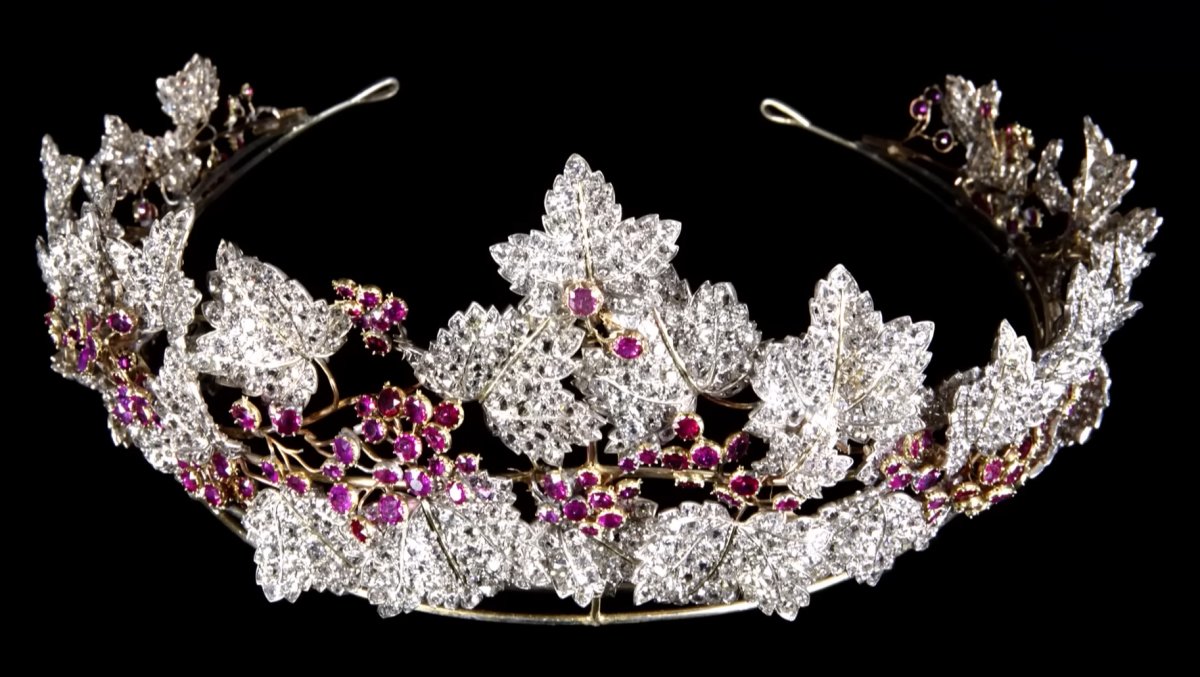
The result was a much fuller and more important tiara that fit with the historical significance of the parure but still respected the garland origins of the jewelry pieces used to make the piece. The arrangement of the diamond leaves and ruby berries still strongly resembles the current branches that were originally created for Désirée more than a century earlier.
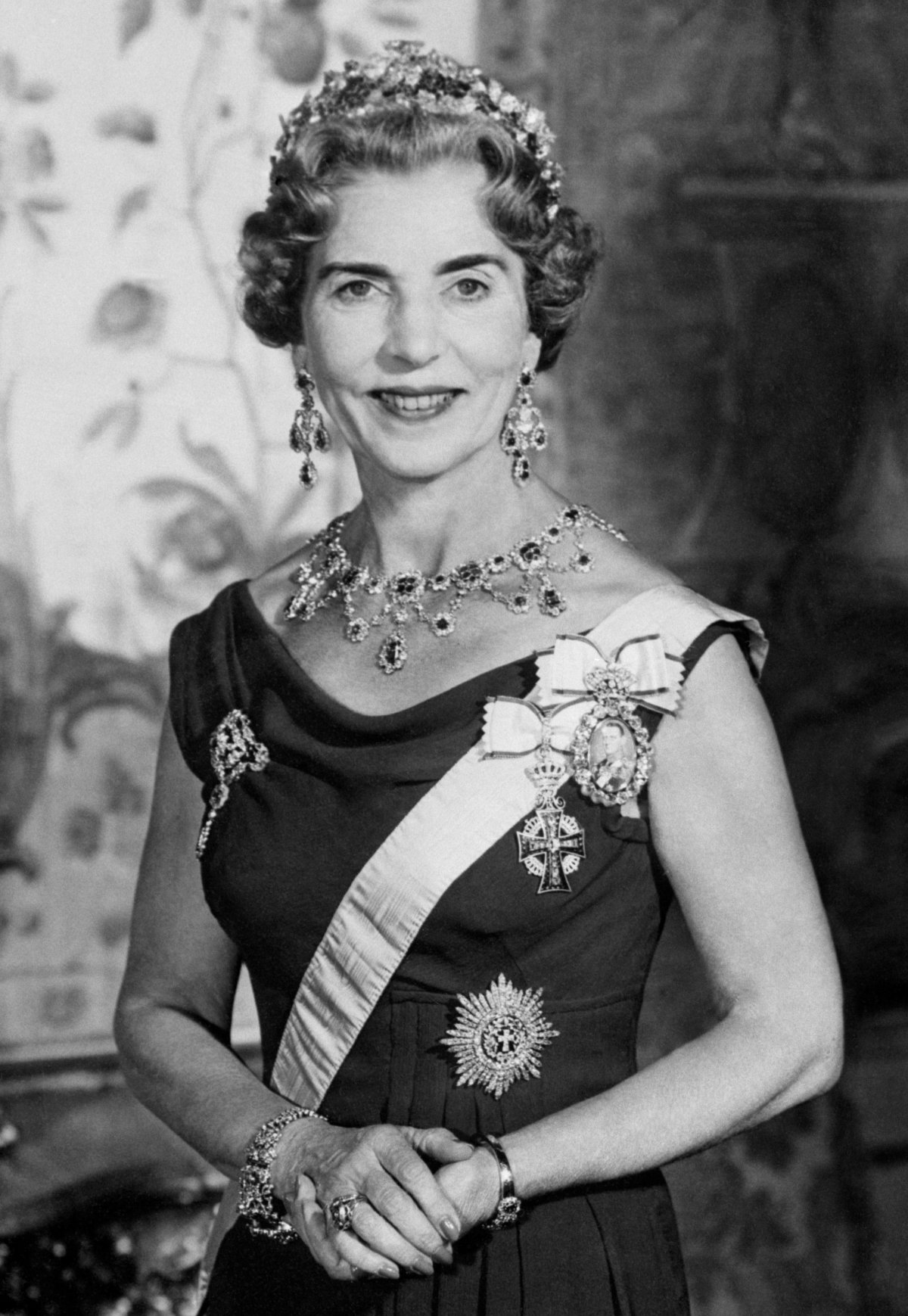
Here’s one of the most famous portraits of Queen Ingrid wearing the entire ruby parure, including the redesigned tiara. Along with the tiara, she wears the girandole earrings, the festoon necklace, the bracelet, and the brooch with its pendant. The other jewels worn in the picture are other pieces from the Danish vaults, not part of the parure. The large diamond floral bracelet on her right wrist, for example, is a legacy from Queen Louise of Sweden, the mother of Queen Lovisa of Denmark.
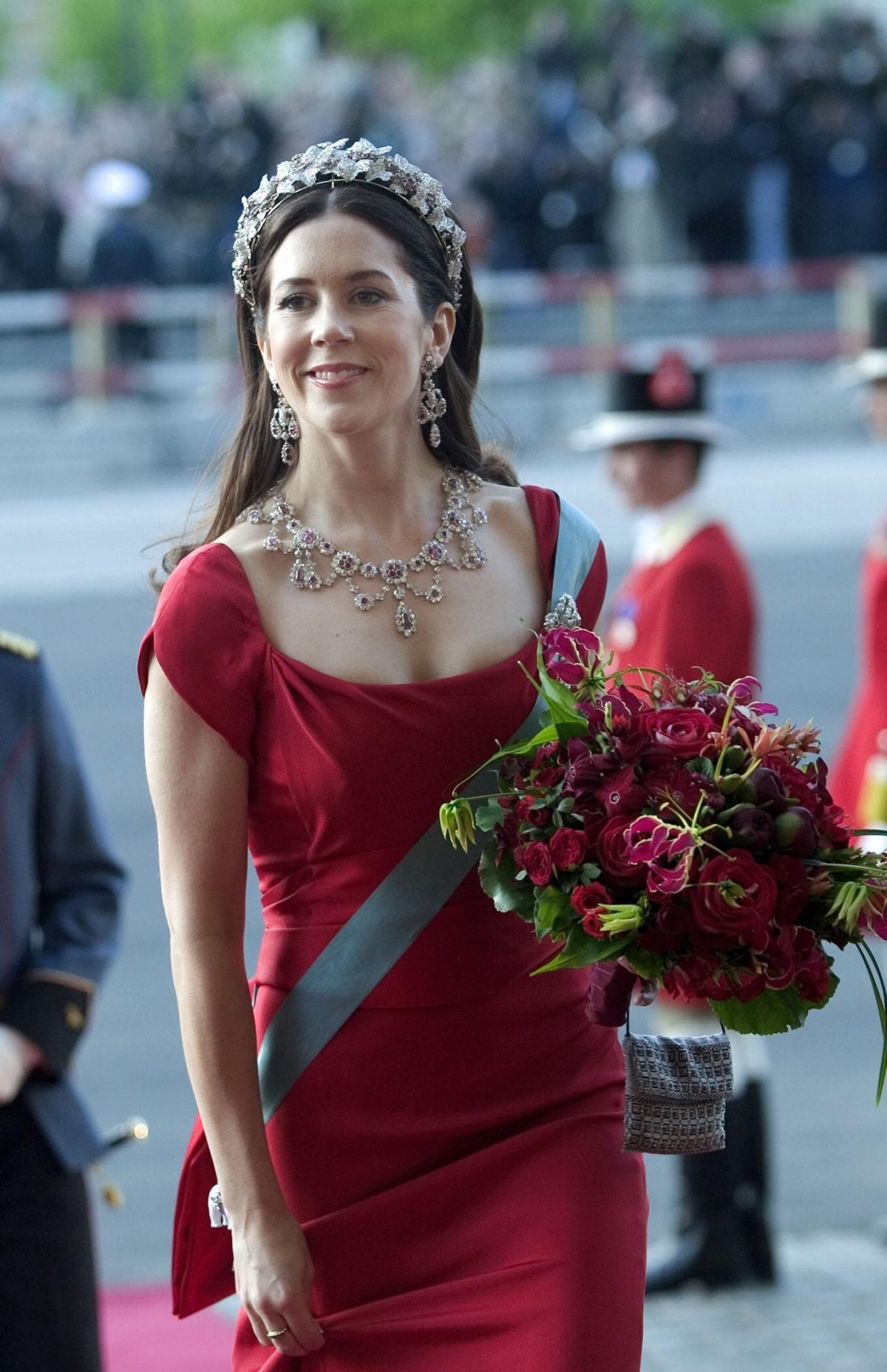
Queen Ingrid passed away in 2000. She decided to leave the rubies to her grandson, Crown Prince Frederik of Denmark, in hopes that his future wife would one day wear the set. By that time, Frederik had already met the woman he would marry: Mary Elizabeth Donaldson, whom he had met in Sydney during the Summer Olympics in 2000. When they married in 2004, she began wearing the ruby set for gala occasions, including a pair of memorable appearances before their royal wedding.
This image of Mary wearing the ruby tiara from her pre-wedding gala shows just how large Ingrid’s tiara was after it was redesigned. The tiara was so massive that it did not fit particularly well on Mary’s hair, with her sleeker hairstyle. Accordingly, in 2010, Frederik and Mary decided to have the ruby tiara reworked so that it would sit more comfortably on Mary’s head. The jewelers at Dulong Fine Jewelry took on the two-year project, redesigning the tiara and reworking the rest of the set to make it more versatile.
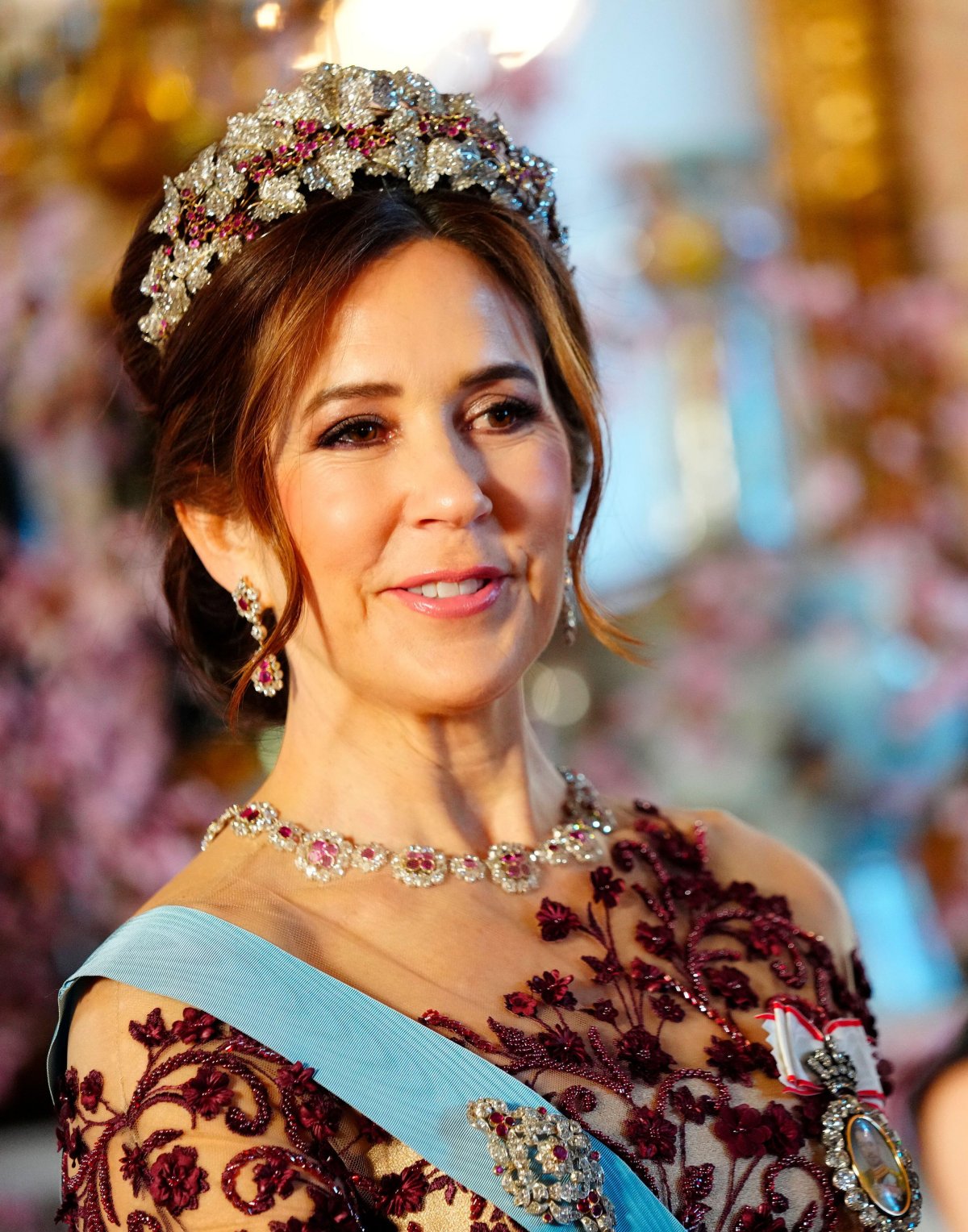
The result was a smaller, more compact version of the wreath tiara, which visually fits Mary’s head better than the original. Alterations were also made to the other pieces of the set, so that they could be worn in their original settings or in various other configurations. Here’s a look at each of the pieces from the parure as it exists today, including some of the alternate settings for a few of the pieces.
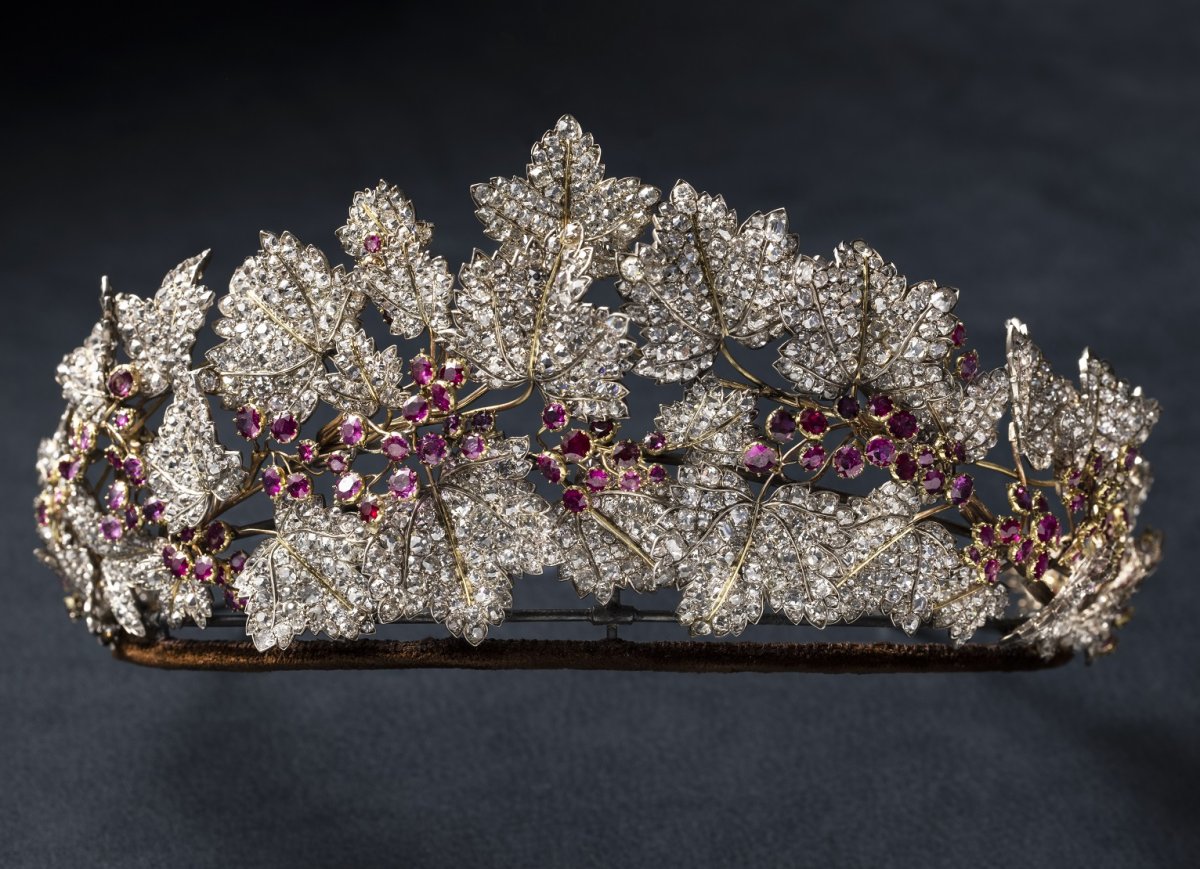
Here’s the current arrangement of the ruby and diamond currant tiara. The shape of the piece is similar to that of the tiara commissioned by Queen Ingrid, though its leaves are arranged much more tightly and its berries are largely concentrated in the center of the piece. A few ruby berries are scattered within the diamond leaves as well.
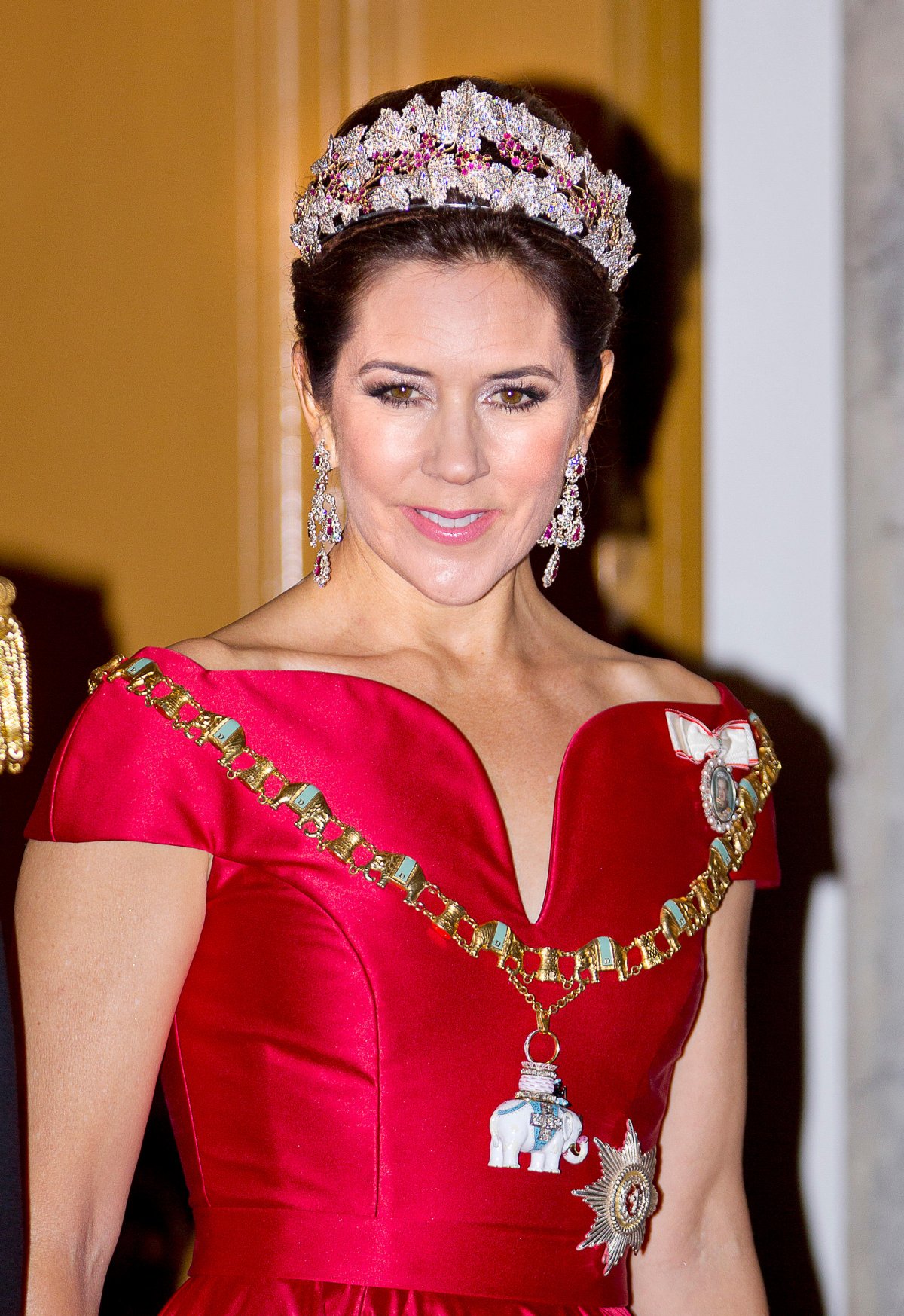
This is the way that the tiara now looks on Mary, who has continued to wear the set since becoming Queen of Denmark in 2024. She had to tip Ingrid’s version of the tiara further backward, but now, she’s able to wear her version in a more upright position.
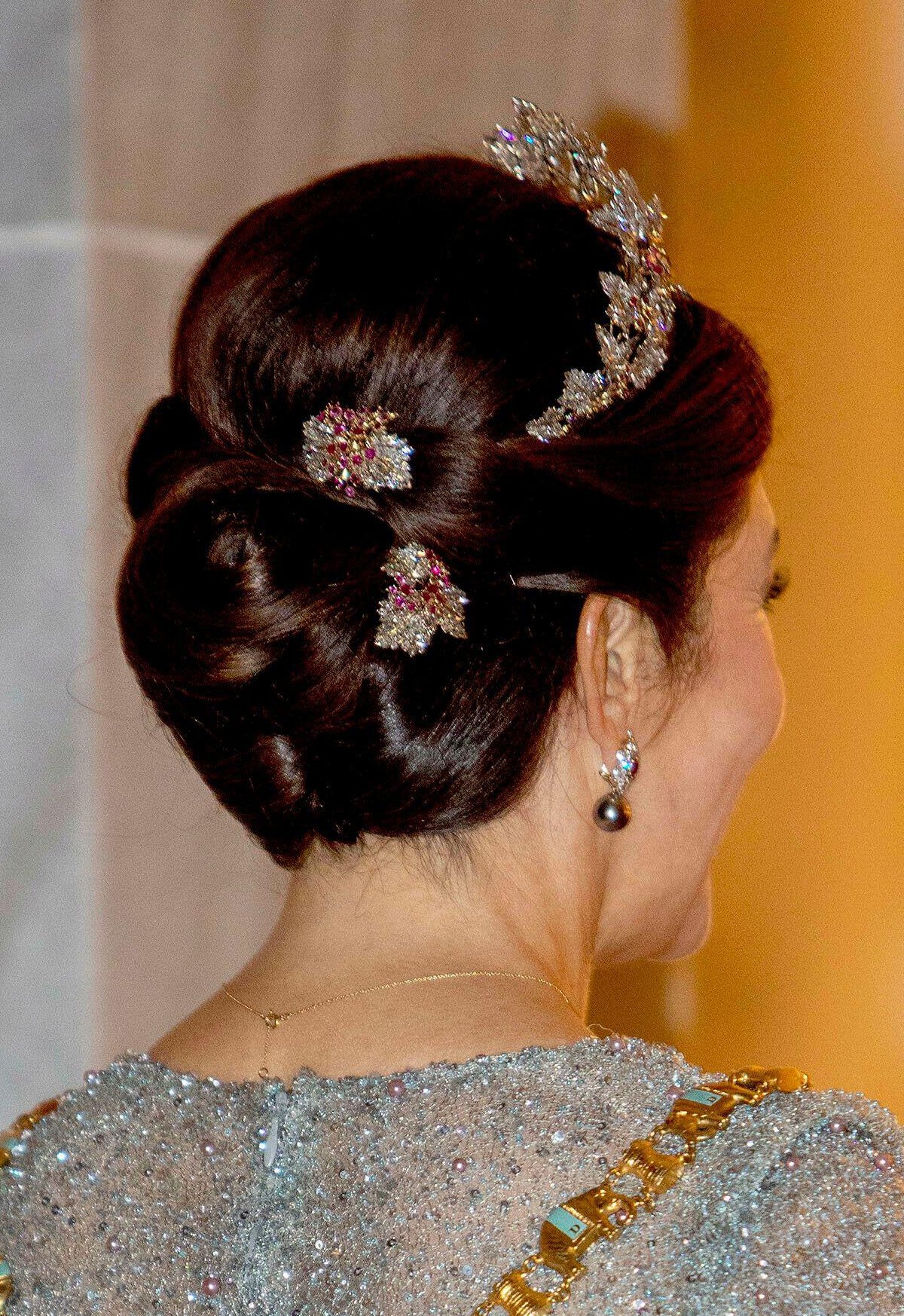
When the changes commissioned by Mary and Frederik were completed, there were several diamond and ruby leaf and berry ornaments from Ingrid’s tiara that could not be reincorporated into the new version. Accordingly, Mary and Frederik decided to have three of these arranged so that they could be used as hair pins, and Søren Hedegaard, Mary’s hairdresser, offered input on how they should be constructed. Mary often wears the pins when she wears the rest of the suite.
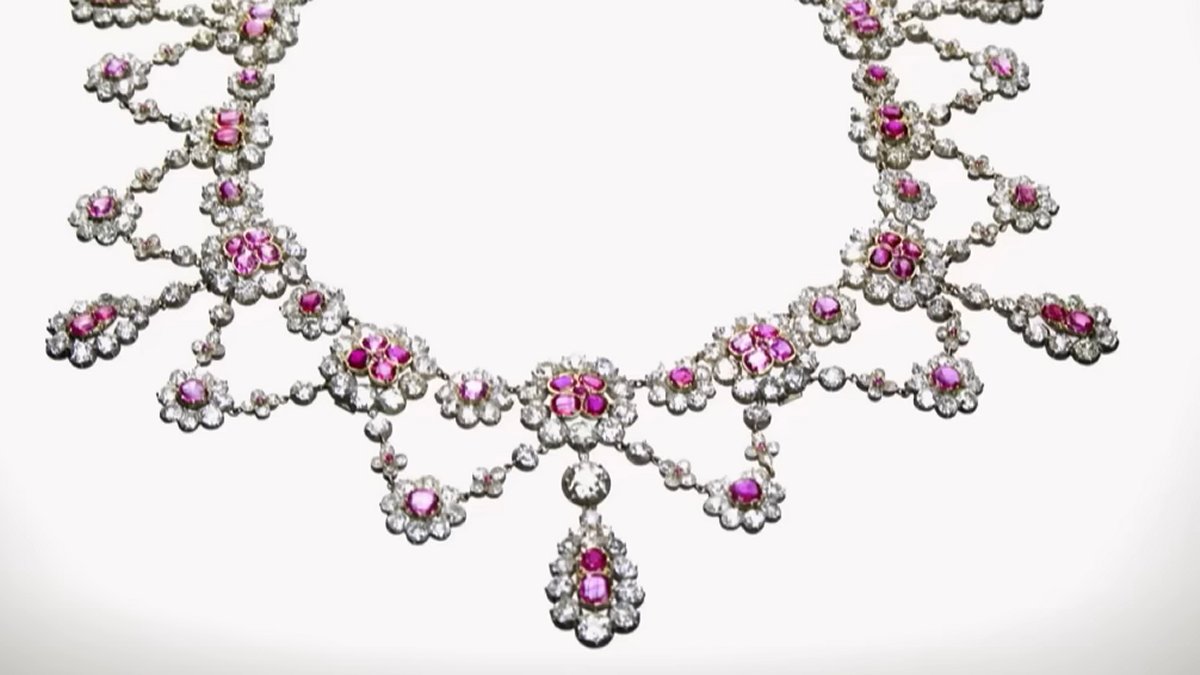
The classic festoon necklace from the suite was also rebuilt during the renovation of the parure. The original design of the piece was kept, but a set of new connecting mechanisms were created that would allow the piece to also be worn without the festoons or pendants, making the necklace much more versatile.
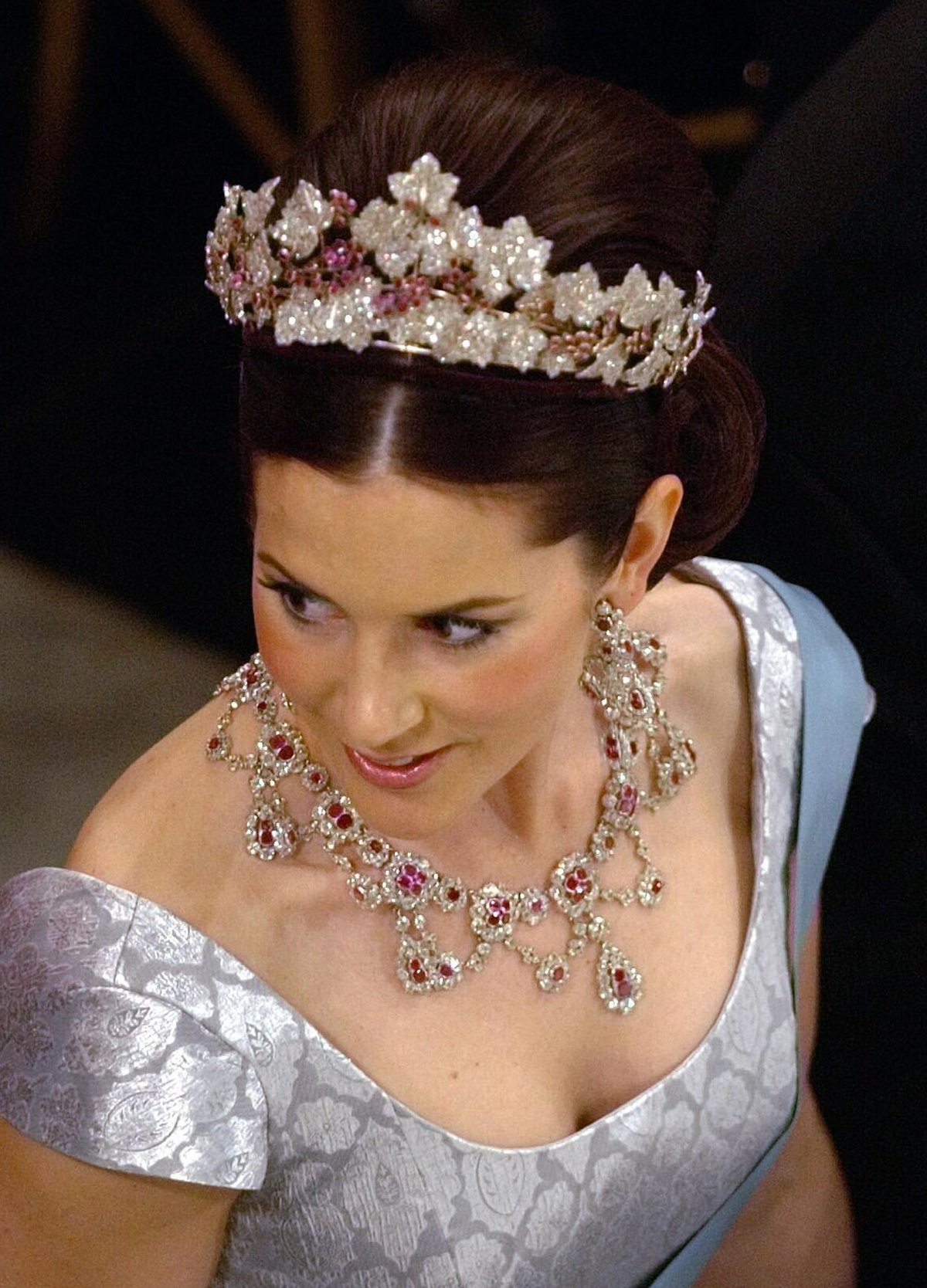
Here’s Mary wearing the pre-renovation festoon necklace, to give you an idea of its sheer size.
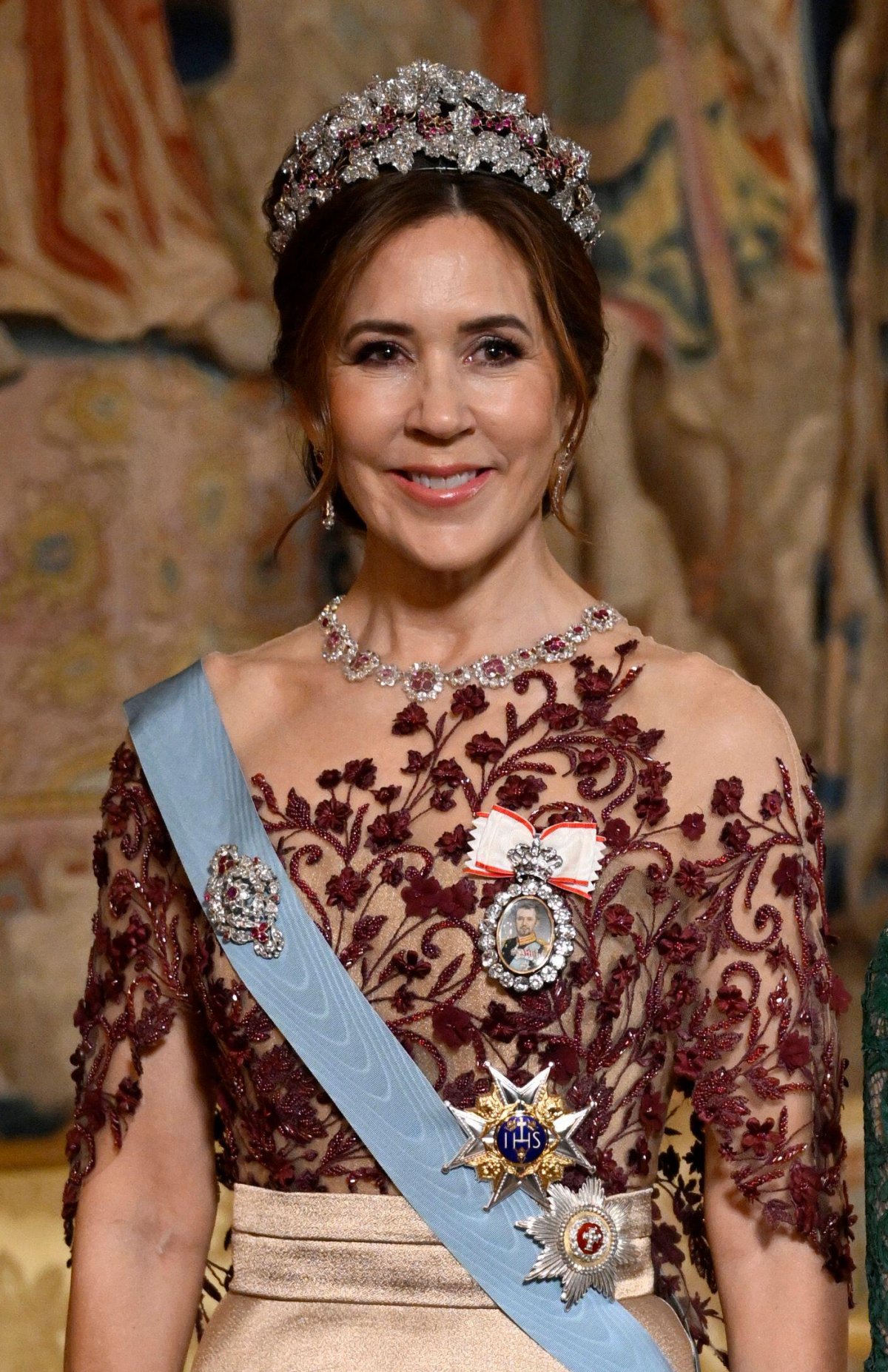
Today, Mary still sometimes wears the complete festoon necklace with its pendants, but she also often wears a smaller version without the festoon or pendant elements. The added versatility lets Mary wear the rubies with gowns that feature different necklines.
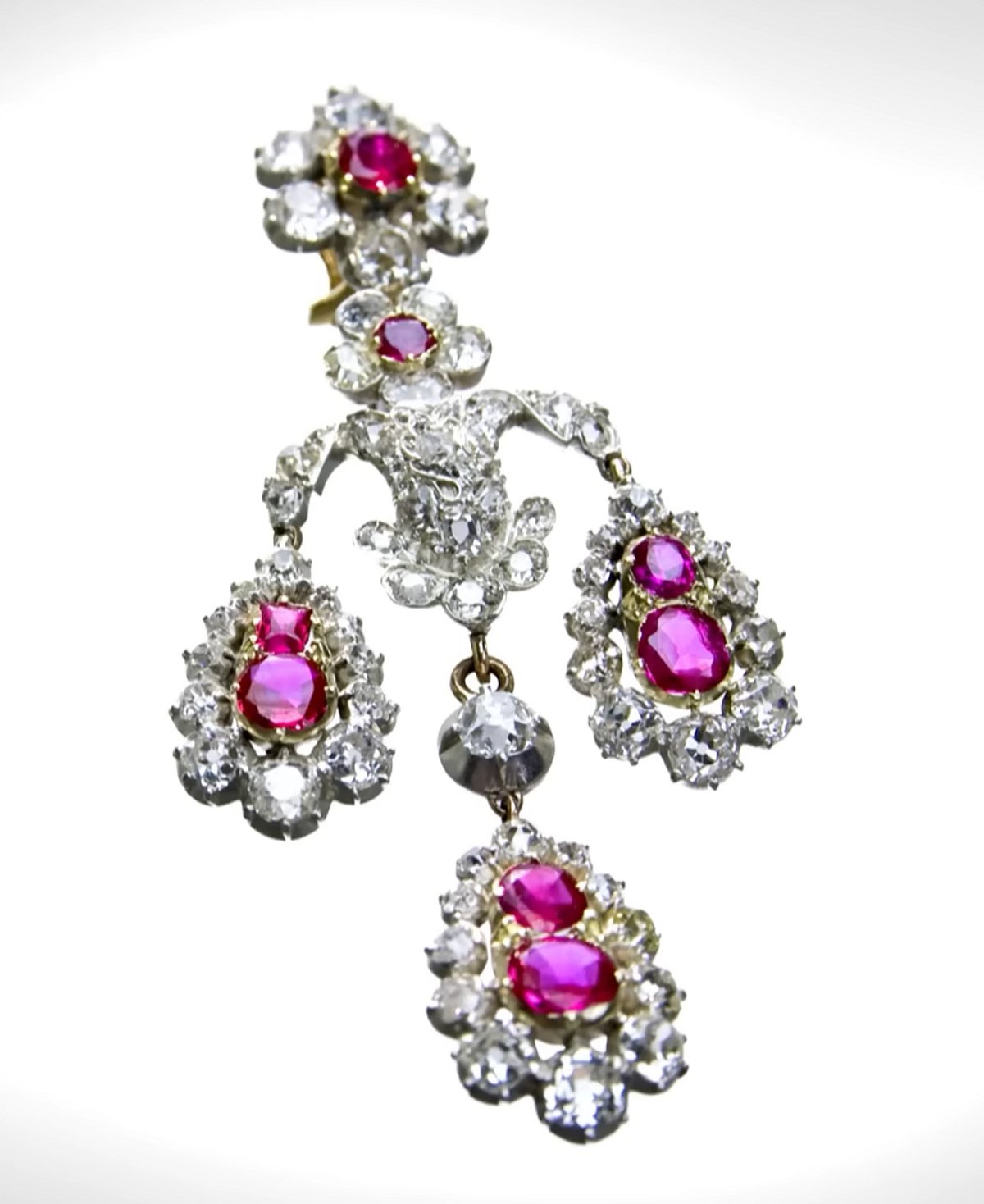
Here’s a look at one of the original girandole earrings from the set. Like the necklace, the earrings were reconstructed so that they can be worn either as complete girandoles or in different smaller settings. Mary likes to wear a setting, for example, that uses just the cluster stud and the central pendant. The stud can also be attached to different gemstone drops, including a set of pearls.
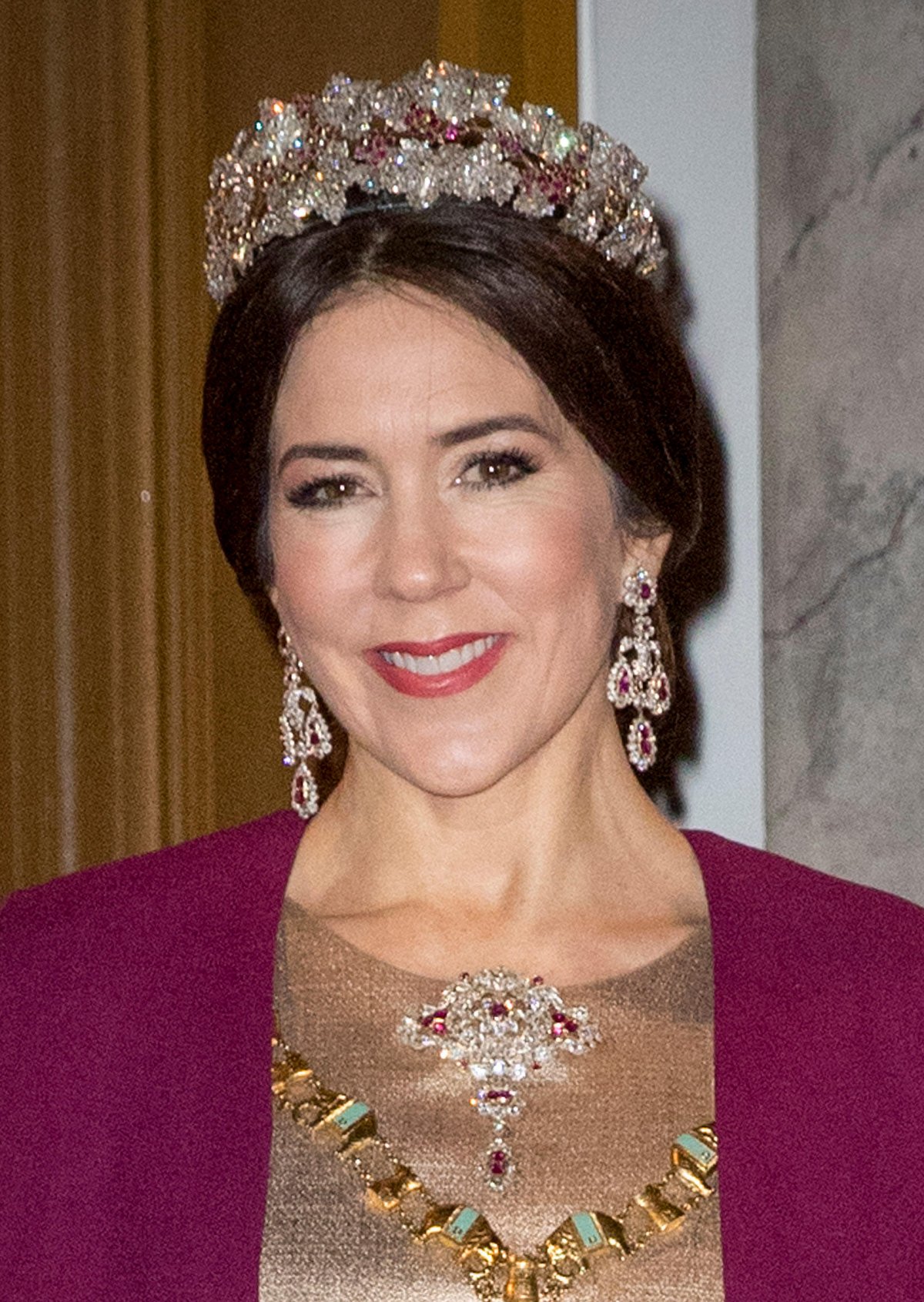
Here’s Mary wearing the earrings in their full girandole form a few years after the parure’s renovation.
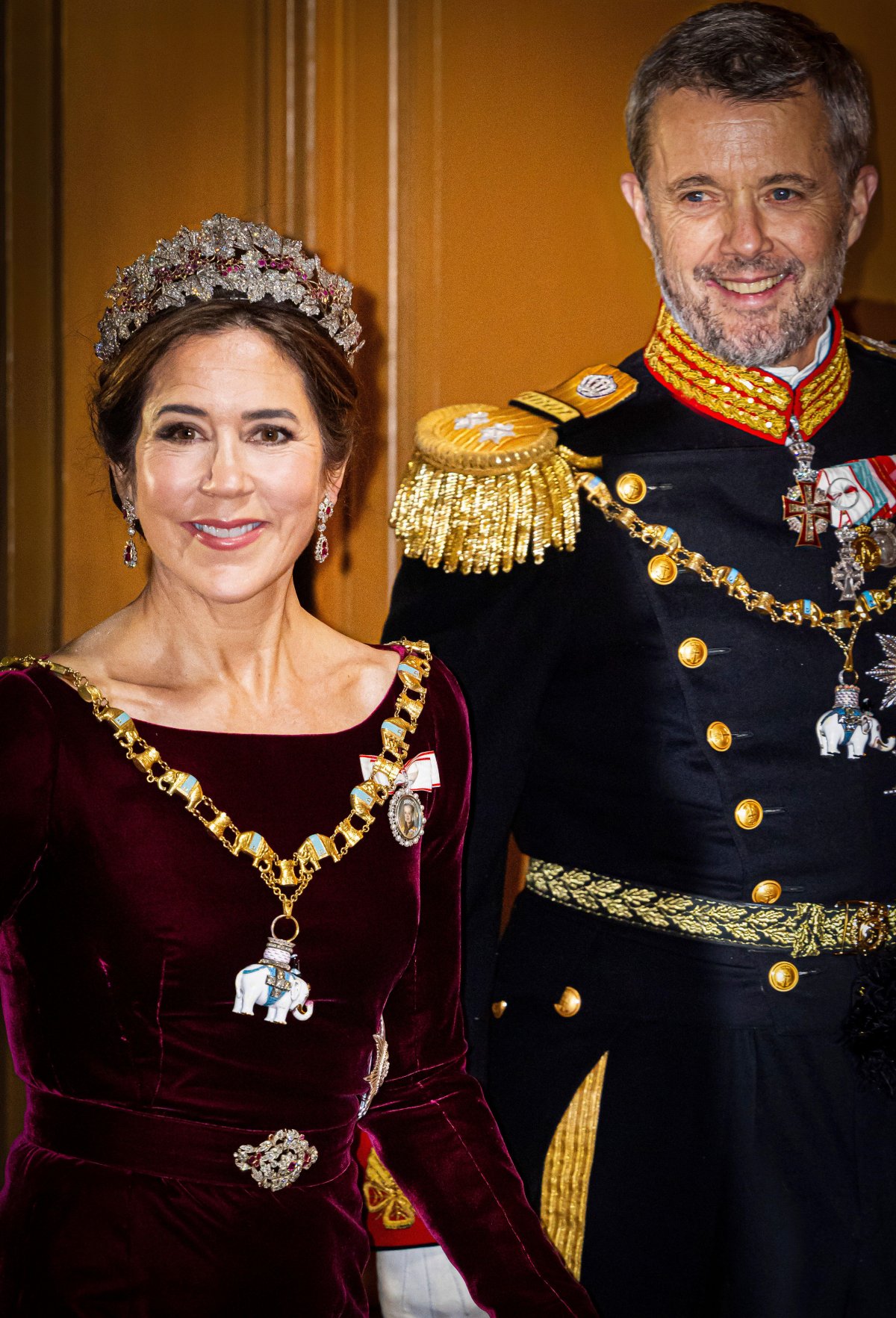
And here, she wears the single pendant setting of the earrings last year for the New Year’s reception at Amalienborg. This version of the earring has become the setting that Mary wears most often.
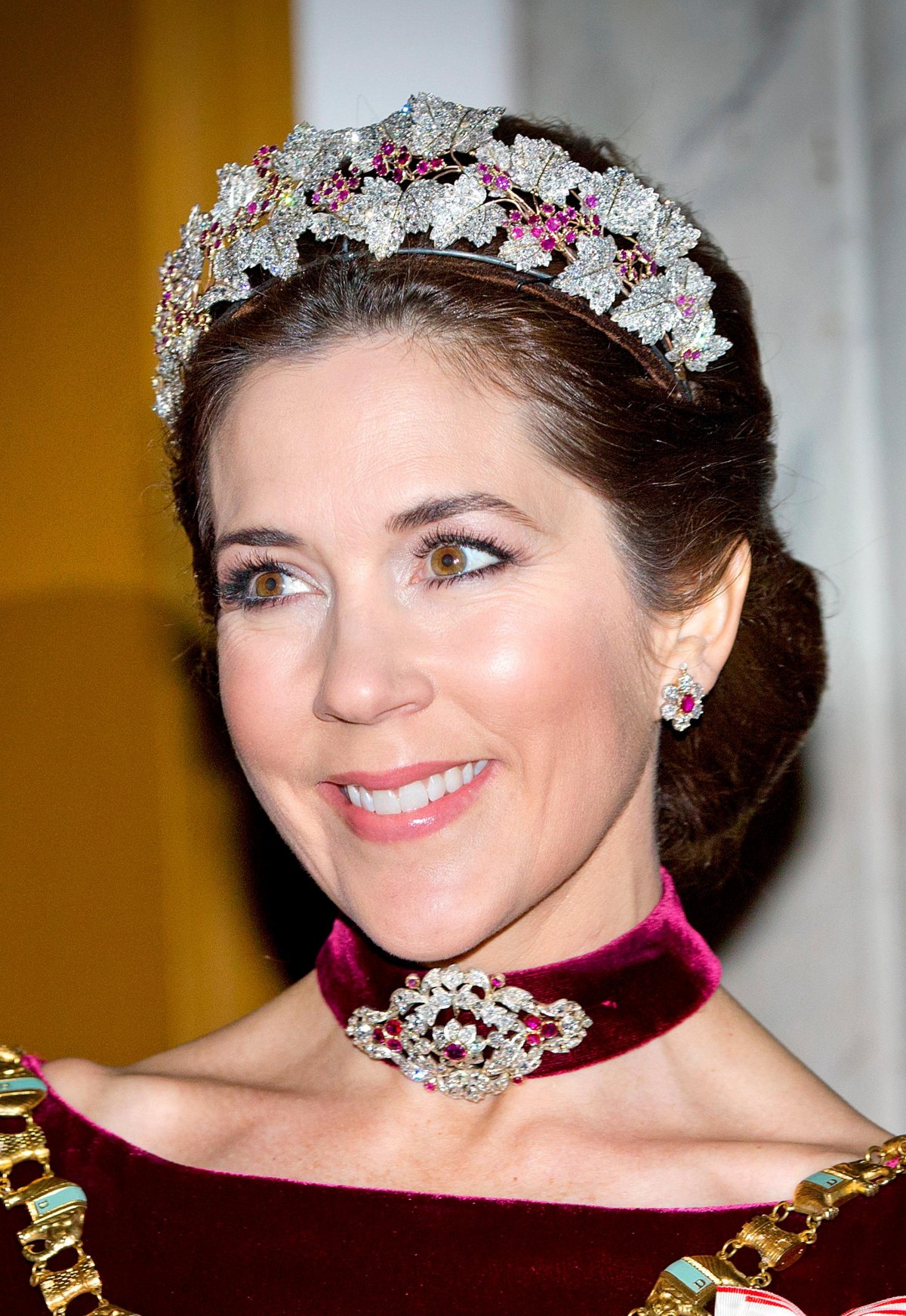
And here’s a view of Mary wearing the cluster stud from the earrings alone. These truly have become extremely wearable and useful in their new versatile form.
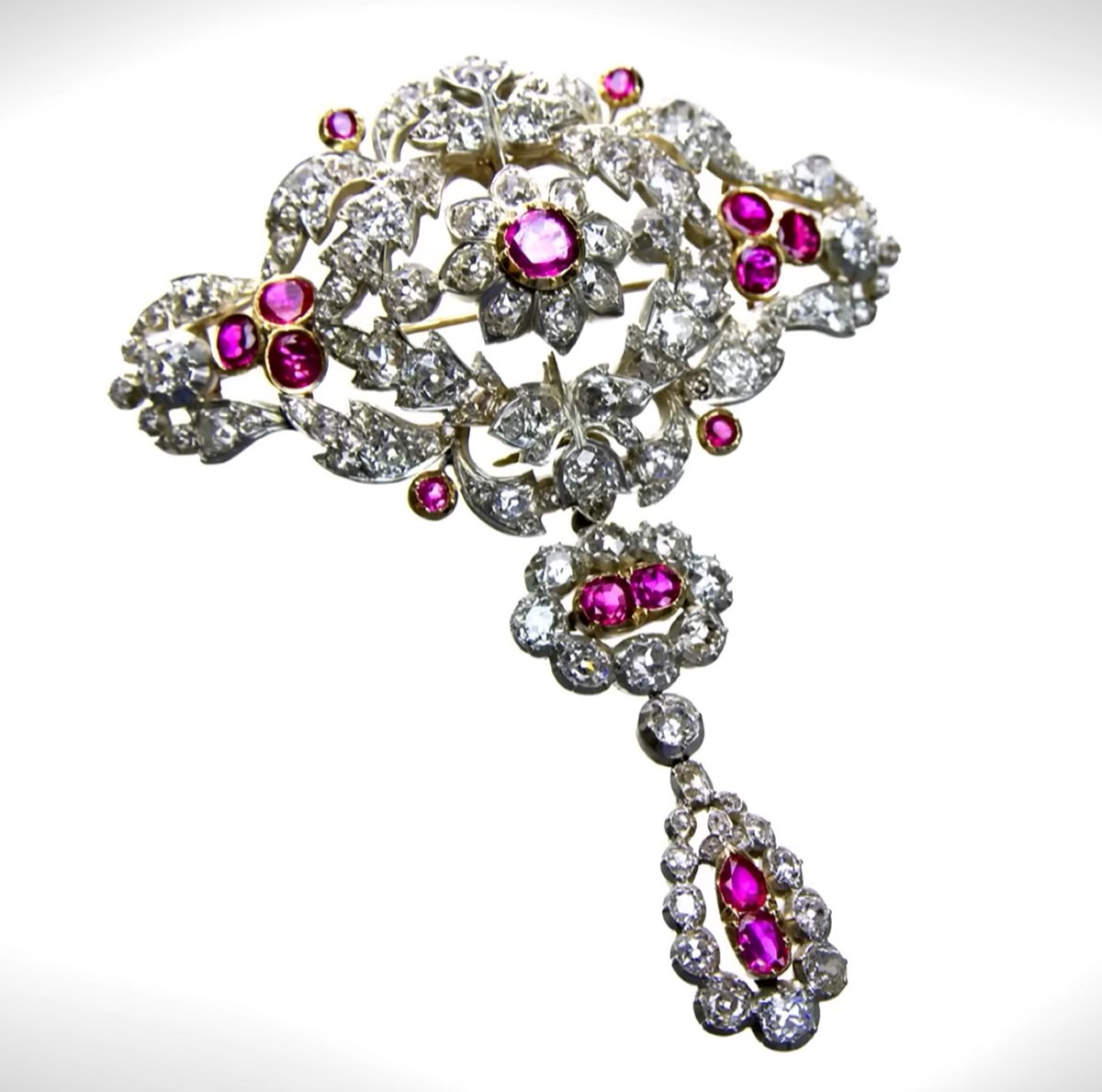
And here’s the brooch from the suite in its original full form. The piece can be worn with or without its pendant, and Mary wears it in both settings today, though she uses it most frequently without the pendant.
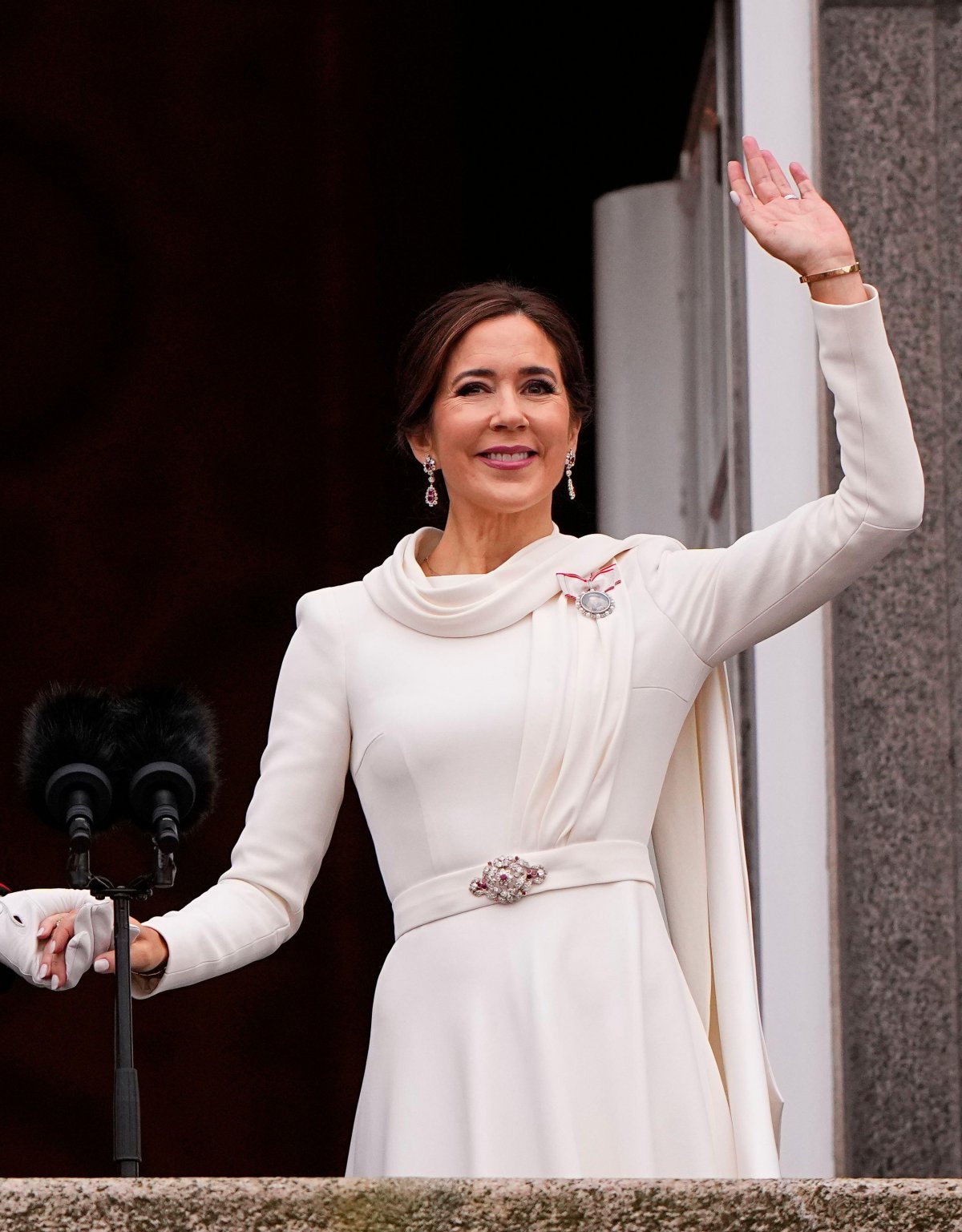
Without its pendant, the brooch is able to be worn for a range of important daytime events as well as evening gala occasions. When King Frederik was proclaimed monarch in January 2024, Mary pinned the pendant-less brooch to the waist of her dress for her first public appearance as Queen of Denmark.
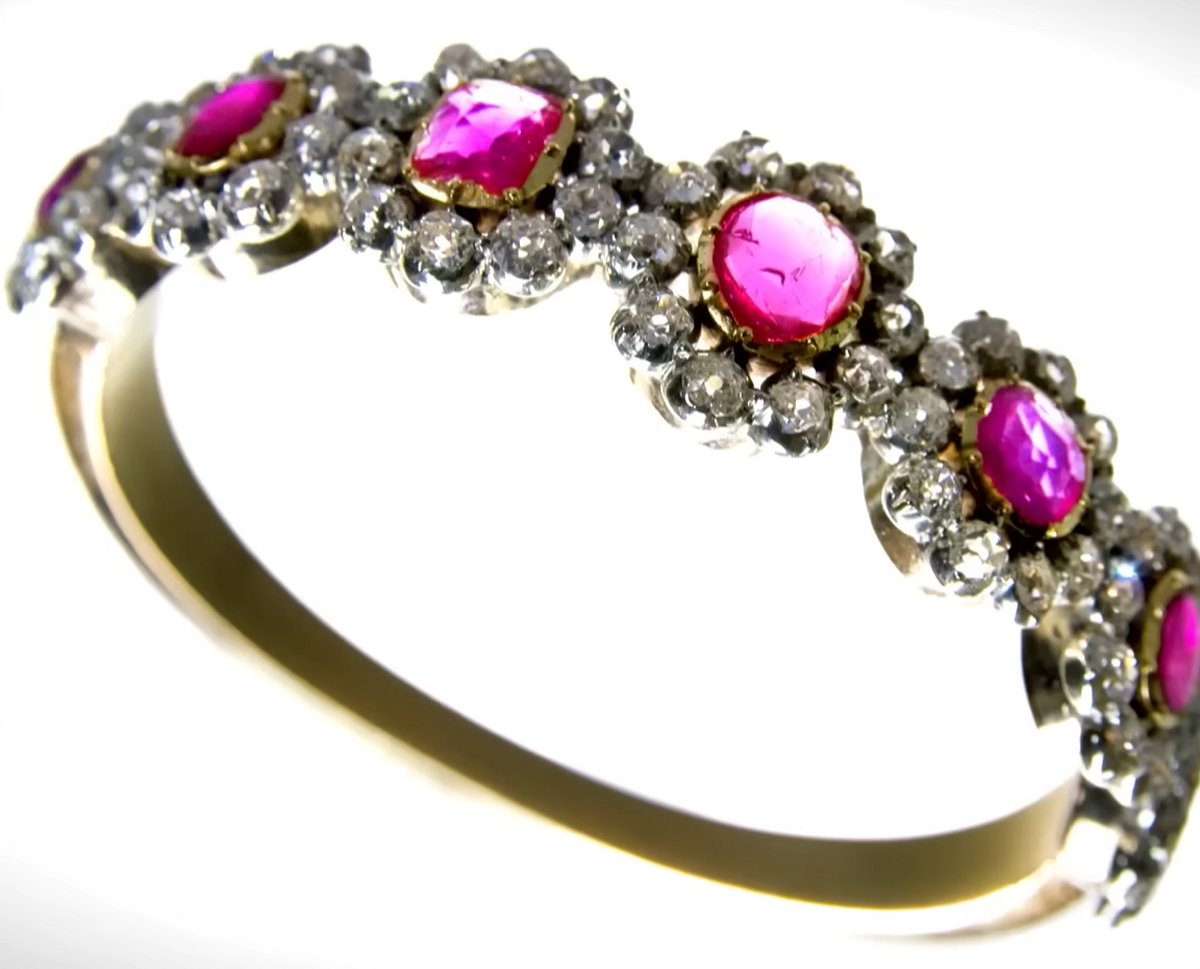
Here’s a closer look at the gold, diamond, and ruby bangle bracelet from the suite. Norwegian jewelry historian Trond Norén Isaksen shares that the bracelet was made at some time before 1926 by repurposing the hair comb that was originally part of Désirée’s original demi-parure.
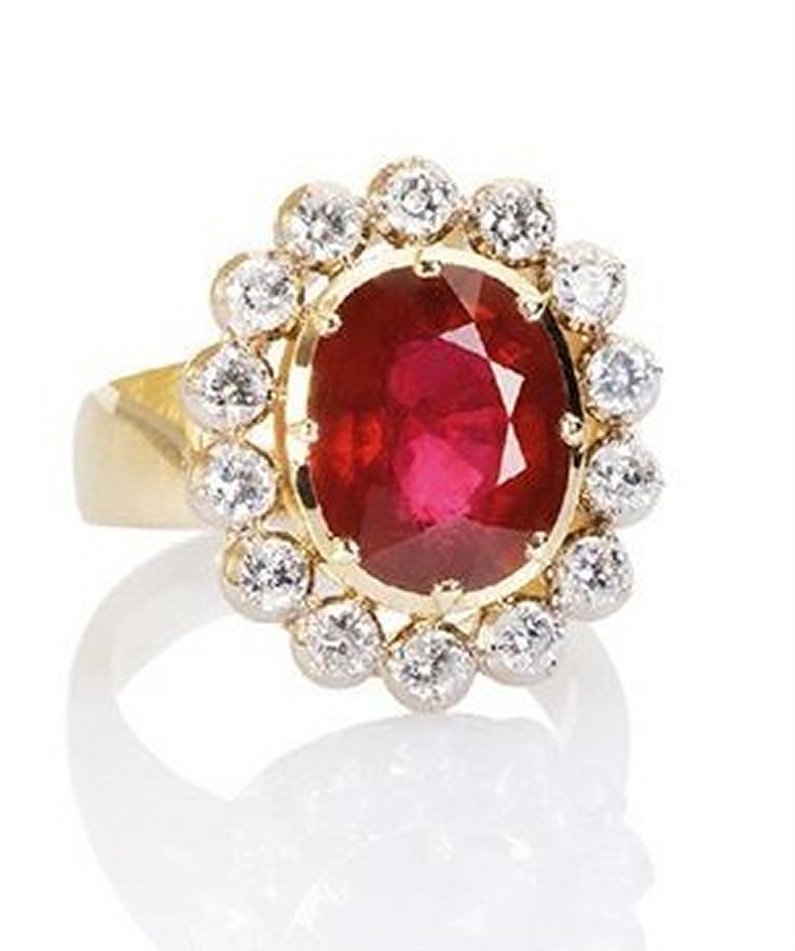
And here’s the most recent addition to the set. When Frederik and Mary asked Dulong to renovate the suite, Mary also asked them to create a diamond and ruby ring to complete the parure. The ring’s yellow gold band was made so that it echoes the shape of the set’s bracelet, adding cohesiveness to the overall look. Ironically, this new ring possibly contains the largest ruby incorporated into the entire parure.
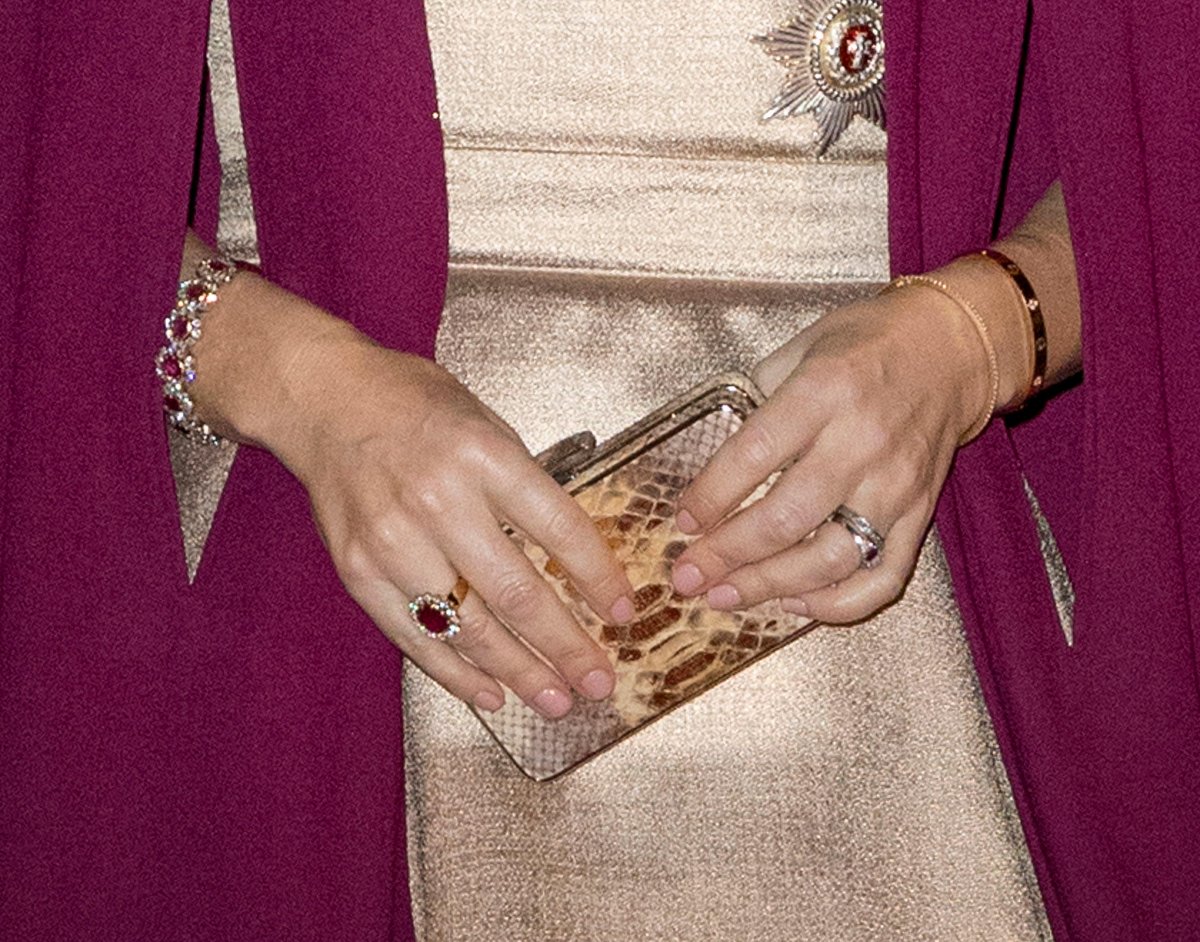
Here, Mary wears both the bracelet and the ring for an appearance that also included the tiara, the girandole earrings, and the complete brooch. I know there are some who were disappointed that Mary and Frederik made changes to the ruby set, but I think that making small changes to historical sets of royal jewelry is the key to keeping them wearable as the decades pass. And that’s ultimately always what I want: to see these precious, historic pieces of jewelry continue to sparkle on wearers today.
Leave a Reply
You must be logged in to post a comment.